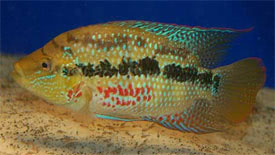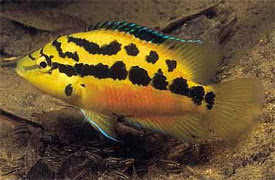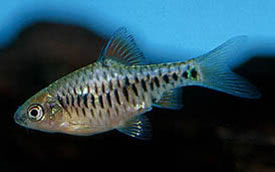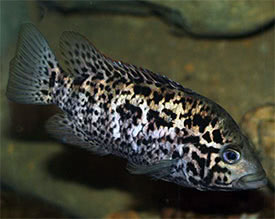
 Magyarul / Hungarian
Magyarul / Hungarian




- Scientific name: Cichlasoma salvini
- Synonyms: Cichlasoma tenue, Heros salvini, Heros triagramma
- Common name: Salvini, Salvin's Cichlid
- Group: Cichlids
- Habitat: Central America; Honduras, Guatemala, Belize and the Eastern parts of Southern Mexico.
- Size: Male: 15 cm, female: 12 cm, in nature they can reach 22 cm in length.
- Biotope: Inhabits in lakes and rivers of the Atlantic slope in northern Central America in jungle or tropical forest areas.
- Social behavior: Territorial, and aggressive for its size, yet the fish does not burrow nor damage plants. Keep only with similar sized and similar agressive species. Small fish will be eaten. During spawning the aggression intensify.
- Diet: Omnivorous; They will eat almost any live and frozen foods, flake foods, and occasionally they require some vegetable matter.
- Breeding: Quite easy
- Tank: Minimum 150 litres for 1 pair
- Population: 1 male and 3-4 females for 400 litres
- Decoration: Sand substrate and lots of hiding places created from rocks and roots. They also need large, open areas for swimming.
- Temperature: 22-30 °C
- pH: 6.5-8
- Hardness: 8-15 NK°
- Lifespan: 10-13 years
Description: Cichlasoma salvini’s name was given in honor to the English explorer O. Salvin, who retrieved an extensive collection of Central American fauna for the British museum from his expedition. They have a bright yellow base coloration. The males have beautiful blue highlights on the back above the lateral line and blue streaks on the head, while the females have a bright and attractive red coloration in the ventral and dorsal areas. In contrast, the males' belly color normally just show a hint of this beautiful red color. Breeding coloration in both fish show a diminishing of the blue intensity, and also black markings appear on their body, from the upper lip to the caudal peduncle along the lateral line and on the dorsal area of the flanks. The yellow base coloration also intensifies during breeding. Young Cichlasoma salvini just show a very small hint of the beautiful adult coloration, and are easily told apart from other species by a circular black blotch on the middle part of the flanks. If only Salvin's Cichlid is kept in the tank, it will be quite shy until mature or until the natural domination order has been established. If a single fish of Cichlasoma salvini is kept alone, it will be extremely shy, usually choosing to hide until feeding time. It is best to keep them in pairs or in a small group. It is hard to keep more than one adult male in a home aquarium, unless it is a very large tank, as they are aggressive. It is not a recommended fish for the beginner aquarists, though doesn't require a large tank like some of the north and central American cichlids.
The sexes are readily distinguished; the male has pointed dorsal and anal fins, and brighter colors with noticeable contrast between patches of black. The female has a patch in the center of her dorsal fin, and a dark spot on the lower edge of her gill cover. Best breed them in pairs, but it may take some time for them to pair up. A good method could be to buy and grow up 5-6 juvenile fish. Buying two mature fish certainly does not mean that they will pair up and if they don't, aggression will soon ensue. In nature they breed in the dry season, between December and May, when the rivers and lagoons turns clearer and warmer. Cichlasoma salvini shows an extraordinary aggressiveness and pairs are able to defend a territory larger than two meters in diameter, even against larger cichlids. The fish are open breeders, laying clutches with as many as 500 greenish or yellowish eggs on carefully cleaned rock sor roots. Both parents care for the fry, which are carefully guarded. The male usually defends the territory, while the female stays close to the eggs and uses her pectoral fins to fan the eggs with water. Two days later the eggs hatch, and after the fry consumed their yolk sacs, they, start swimming and looking for food. Artemia nauplii can be a good starter food for them.





























